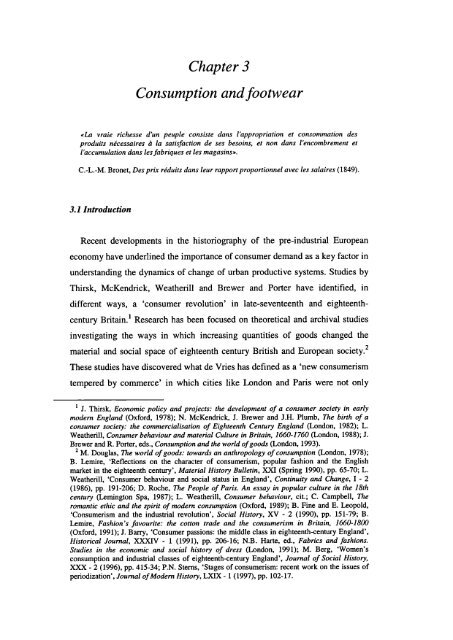The Boot and Shoe Trades in London and Paris in the Long Eighteenth Century
The Boot and Shoe Trades in London and Paris in the Long Eighteenth Century
The Boot and Shoe Trades in London and Paris in the Long Eighteenth Century
You also want an ePaper? Increase the reach of your titles
YUMPU automatically turns print PDFs into web optimized ePapers that Google loves.
Chapter 3<br />
Consumption <strong>and</strong> footwear<br />
La vraie richesse d'un peuple consiste dans l'appropriation et consommation des<br />
produits nécessaires a Ia satisfaction de ses beso<strong>in</strong>s, et non dans l'encombrement et<br />
l'accumulation dans lesfabriques et les magas<strong>in</strong>s.<br />
C.-L.-M. Bronet, Des prix réduits dans leur rapport proportionnel avec les salaires (1849).<br />
3.1 Introduction<br />
Recent developments <strong>in</strong> <strong>the</strong> historiography of <strong>the</strong> pre-<strong>in</strong>dustrial European<br />
economy have underl<strong>in</strong>ed <strong>the</strong> importance of consumer dem<strong>and</strong> as a key factor <strong>in</strong><br />
underst<strong>and</strong><strong>in</strong>g <strong>the</strong> dynamics of change of urban productive systems. Studies by<br />
Thirsk, McKendrick, Wea<strong>the</strong>rill <strong>and</strong> Brewer <strong>and</strong> Porter have identified, <strong>in</strong><br />
different ways, a 'consumer revolution' <strong>in</strong> late-seventeenth <strong>and</strong> eighteenth-<br />
century Brita<strong>in</strong>.' Research has been focused on <strong>the</strong>oretical <strong>and</strong> archival studies<br />
<strong>in</strong>vestigat<strong>in</strong>g <strong>the</strong> ways <strong>in</strong> which <strong>in</strong>creas<strong>in</strong>g quantities of goods changed <strong>the</strong><br />
material <strong>and</strong> social space of eighteenth century British <strong>and</strong> European society.2<br />
<strong>The</strong>se studies have discovered what de Vries has def<strong>in</strong>ed as a 'new consumerism<br />
tempered by commerce' <strong>in</strong> which cities like <strong>London</strong> <strong>and</strong> <strong>Paris</strong> were not only<br />
J. Thirsk, Economic policy <strong>and</strong> projects: <strong>the</strong> development of a consumer society <strong>in</strong> early<br />
modern Engl<strong>and</strong> (Oxford, 1978); N. McKendrick, J. Brewer <strong>and</strong> J.H. Plumb, <strong>The</strong> birth of a<br />
consumer society: <strong>the</strong> commercialisation of <strong>Eighteenth</strong> <strong>Century</strong> Engl<strong>and</strong> (<strong>London</strong>, 1982); L.<br />
Wea<strong>the</strong>rill, Consumer behaviour <strong>and</strong> material Culture <strong>in</strong> Brita<strong>in</strong>, 1660-1 760 (<strong>London</strong>, 1988); J.<br />
Brewer <strong>and</strong> R. Porter, eds., Consumption <strong>and</strong> <strong>the</strong> world of goods (<strong>London</strong>, 1993).<br />
2 M. Douglas, <strong>The</strong> world of goods: towards an anthropology of consumption (<strong>London</strong>, 1978);<br />
B. Lemire, 'Reflections on <strong>the</strong> character of consumerism, popular fashion <strong>and</strong> <strong>the</strong> English<br />
market <strong>in</strong> <strong>the</strong> eighteenth century', Material History Bullet<strong>in</strong>, XXI (Spr<strong>in</strong>g 1990), pp. 65-70; L.<br />
Wea<strong>the</strong>rill, 'Consumer behaviour <strong>and</strong> social status <strong>in</strong> Engl<strong>and</strong>', Cont<strong>in</strong>uity <strong>and</strong> Change, I - 2<br />
(1986), pp. 191-206; D. Roche, <strong>The</strong> People of <strong>Paris</strong>. An essay <strong>in</strong> popular culture <strong>in</strong> <strong>the</strong> 18th<br />
century (Lem<strong>in</strong>gton Spa, 1987); L. Wea<strong>the</strong>rill, Consumer behaviour, cit.; C. Campbell, <strong>The</strong><br />
romantic ethic <strong>and</strong> <strong>the</strong> spirit of modern consumption (Oxford, 1989); B. F<strong>in</strong>e <strong>and</strong> E. Leopold,<br />
'Consumerism <strong>and</strong> <strong>the</strong> <strong>in</strong>dustrial revolution', Social History, XV - 2 (1990), pp. 151-79; B.<br />
Lemire, Fashion's favourite: <strong>the</strong> cotton trade <strong>and</strong> <strong>the</strong> consumerism <strong>in</strong> Brita<strong>in</strong>, 1660-1800<br />
(Oxford, 1991); J. Barry, 'Consumer passions: <strong>the</strong> middle class <strong>in</strong> eighteenth-century Engl<strong>and</strong>',<br />
Historical Journal, XXXIV - 1 (1991), pp. 206-16; N.B. Harte, ed., Fabrics <strong>and</strong> fashions.<br />
Studies <strong>in</strong> <strong>the</strong> economic <strong>and</strong> social history of dress (<strong>London</strong>, 1991); M. Berg, 'Women's<br />
consumption <strong>and</strong> <strong>in</strong>dustrial classes of eighteenth-century Engl<strong>and</strong>', Journal of Social History,<br />
XXX - 2 (1996), pp. 415-34; P.N. Stems, 'Stages of consumerism: recent work on <strong>the</strong> issues of<br />
periodization', Journal of Modern History, LXIX - 1(1997), pp. 102-17.


